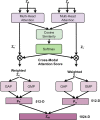Hybrid-FHR: a multi-modal AI approach for automated fetal acidosis diagnosis
- PMID: 38247009
- PMCID: PMC10801938
- DOI: 10.1186/s12911-024-02423-4
Hybrid-FHR: a multi-modal AI approach for automated fetal acidosis diagnosis
Abstract
Background: In clinical medicine, fetal heart rate (FHR) monitoring using cardiotocography (CTG) is one of the most commonly used methods for assessing fetal acidosis. However, as the visual interpretation of CTG depends on the subjective judgment of the clinician, this has led to high inter-observer and intra-observer variability, making it necessary to introduce automated diagnostic techniques.
Methods: In this study, we propose a computer-aided diagnostic algorithm (Hybrid-FHR) for fetal acidosis to assist physicians in making objective decisions and taking timely interventions. Hybrid-FHR uses multi-modal features, including one-dimensional FHR signals and three types of expert features designed based on prior knowledge (morphological time domain, frequency domain, and nonlinear). To extract the spatiotemporal feature representation of one-dimensional FHR signals, we designed a multi-scale squeeze and excitation temporal convolutional network (SE-TCN) backbone model based on dilated causal convolution, which can effectively capture the long-term dependence of FHR signals by expanding the receptive field of each layer's convolution kernel while maintaining a relatively small parameter size. In addition, we proposed a cross-modal feature fusion (CMFF) method that uses multi-head attention mechanisms to explore the relationships between different modalities, obtaining more informative feature representations and improving diagnostic accuracy.
Results: Our ablation experiments show that the Hybrid-FHR outperforms traditional previous methods, with average accuracy, specificity, sensitivity, precision, and F1 score of 96.8, 97.5, 96, 97.5, and 96.7%, respectively.
Conclusions: Our algorithm enables automated CTG analysis, assisting healthcare professionals in the early identification of fetal acidosis and the prompt implementation of interventions.
Keywords: Attention mechanisms; Cardiotocography; Cross-modal feature fusion; Fetal acidosis; Fetal heart rate; Multi-modal; Temporal convolutional network.
© 2024. The Author(s).
Conflict of interest statement
The authors declare no competing interests.
Figures










Similar articles
-
DeepFHR: intelligent prediction of fetal Acidemia using fetal heart rate signals based on convolutional neural network.BMC Med Inform Decis Mak. 2019 Dec 30;19(1):286. doi: 10.1186/s12911-019-1007-5. BMC Med Inform Decis Mak. 2019. PMID: 31888592 Free PMC article. Review.
-
The factor time in fetal heart rate monitoring and the detection of acidosis using the WAS score.Z Geburtshilfe Neonatol. 2014 Apr;218(2):80-6. doi: 10.1055/s-0034-1372596. Epub 2014 Apr 30. Z Geburtshilfe Neonatol. 2014. PMID: 24788837
-
Identifying fetal status with fetal heart rate: Deep learning approach based on long convolution.Comput Biol Med. 2023 Jun;159:106970. doi: 10.1016/j.compbiomed.2023.106970. Epub 2023 Apr 21. Comput Biol Med. 2023. PMID: 37105114
-
FHR patterns that become significant in connection with ST waveform changes and metabolic acidosis at birth.J Matern Fetal Neonatal Med. 2019 Oct;32(19):3288-3293. doi: 10.1080/14767058.2018.1462326. Epub 2018 Apr 18. J Matern Fetal Neonatal Med. 2019. PMID: 29621906
-
A Comprehensive Review of Techniques for Processing and Analyzing Fetal Heart Rate Signals.Sensors (Basel). 2021 Sep 13;21(18):6136. doi: 10.3390/s21186136. Sensors (Basel). 2021. PMID: 34577342 Free PMC article. Review.
References
-
- Liu M, Lu Y, Long S, Bai J, Lian W. An attention-based CNN-BiLSTM hybrid neural network enhanced with features of discrete wavelet transformation for fetal acidosis classification. Expert Syst Appl. 2021;186:115714. doi: 10.1016/j.eswa.2021.115714. - DOI
-
- Georgieva A, Payne SJ, Moulden M, Redman CWG. Artificial neural networks applied to fetal monitoring in labour. Neural Comput Applic. 2013;22(1):85–93. doi: 10.1007/s00521-011-0743-y. - DOI
Publication types
MeSH terms
LinkOut - more resources
Full Text Sources
Medical

